Map turtles are as remarkable in their diversity as they are in their behavior.
They are perhaps one of the most specialized groups of turtles in North America. Their body form is unique: a keeled, serrated carapace, and large, broad forelimbs and paddle-like rear feet. Map and sawback turtles of the genus Graptemys are distinctive and highly evolved, and because of their very specialized adaptations, they have specific requirements in both their natural environments and captive habitats.
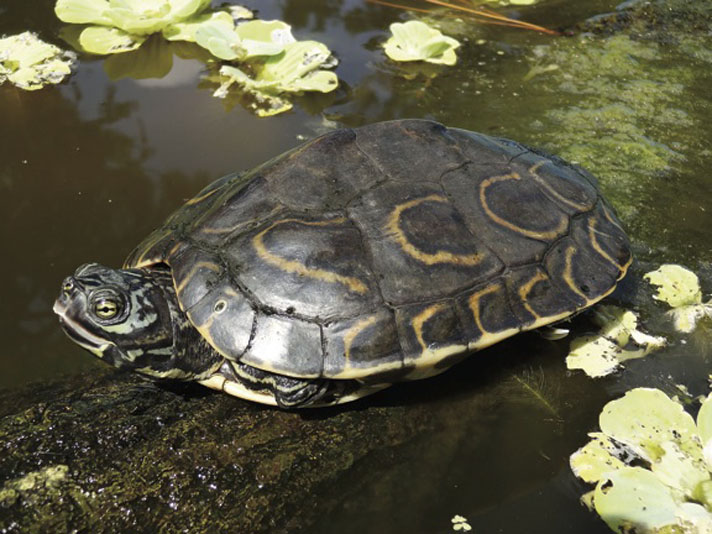
Paul Vander Schouw
Some Barbour’s map turtles are rather plain, but this young adult female’s carapace is adorned with very attractive orange crescents.
Map turtle coloration varies among species, subspecies, and sometimes even localities. In general, they tend to be tan or light brown. Sometimes they’re green or orange, even gray or almost black. Some have blotches, others have speckles or reticulations. There are stripes on the head, neck, limbs and tail, and each species bears a unique facial pattern. The keeled carapace allows map turtles to maintain stability in the flowing rivers where they prefer to live, and their long, strong legs with broadly webbed feet provide the power to swim against all but the swiftest currents.
There are 14 currently recognized species of map turtle native to North America, five of which are considered broad-headed species because of the massively enlarged heads that females develop as they age, and four others that are commonly referred to as sawbacks due to the prominent keels and strongly serrated marginals on the carapace. At the time of writing, one map species and one sawback species are each considered to have a single subspecies, bringing the total number of Graptemys species and subspecies to 16.
Broad-Headed Map Turtles
As mentioned, this group derives its name from the tendency of adult females to develop exaggeratedly large heads as they reach advanced age, a condition known as macrocephaly. In size and shape, the broad-headed species are all variations of a common theme. Hatchlings begin life with a prominent medial keel and strongly serrated marginals. The shell deepens and the keel elevates as the turtles grow, although large adult females develop something of a hump-backed appearance. Sexual dimorphism (the difference in physical appearance between males and females) is significant in the broad-headed map turtle species. Females sometimes grow quite large, up to around 12 inches. Males normally reach only about half that size, up to about 6 inches.
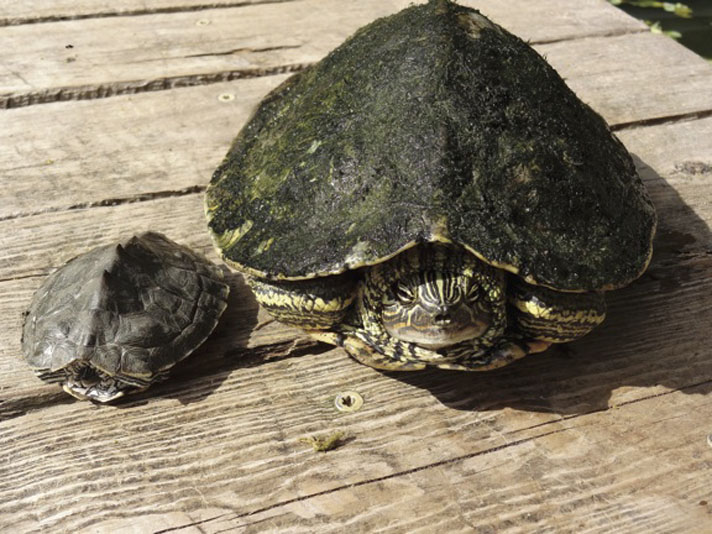
PAUL VANDER SCHOUW
The disparity in size between adult males (L) and adult females (R) is exemplified by this pair of Cagle’s map turtles (Graptemys caglei).
The broad-headed map species occur exclusively in rivers that drain into the northern Gulf of Mexico, from the panhandle of Florida westward to the eastern border of Louisiana. Because they almost never travel on land (with the exception of nesting females), they are restricted to the main run of their respective rivers, oxbow lakes and flooded areas directly connected to the main river. These rivers are typically limestone- or clay-bottomed, with many bends and twists that produce expansive sandbars and sandy beaches.
Juvenile and male broad-headed maps inhabit the shallows and tree-fall snags near the shoreline, feeding primarily on aquatic insects and occasionally fish. Adult females prefer deeper water and consume mostly mollusks and crustaceans, a diet facilitated by their characteristically enlarged heads. This remarkable dichotomy allows these species to inhabit the same waterways, yet exist as essentially separate, non-competing organisms.
The coloration of the broad-headed maps is similar across all five species, with unique coloration/patterns described in the individual accounts that follow. Soft parts are dark-brown or black with light-green, yellow or occasionally orange stripes, and the head is adorned with a solid mask that extends behind and between the eyes. Base carapace color is tan to light olive green, with yellow or pale orange bars or rings in the centers of the costal and marginal scutes of some individuals. There is almost always a black or dark-brown dorsal stripe on the carapace, as well. The plastron is pale yellow to cream with little or no plastral pattern, although some individuals possess dark pigmentation along the scutes’ seams.
The Barbour’s map turtle (G. barbouri) occurs primarily in the Apalachicola and Chipola Rivers of southern Georgia and northern Florida. Recently, there have been verified records of this species occurring further east in the Ochlocknee River, and further west in the Choctawhatchee River. It, along with the Escambia map turtle are the only two broad-headed species that do not have a sawback species occurring in the same river systems. The interorbital (between the eyes) blotch ends in a single point at the nose, but the unique and identifying marking for this species consists of a transverse bar on the chin that runs parallel to the lower jaw.
The Escambia map turtle (G. ernsti) occurs in rivers draining into Escambia Bay, including the Conecuh/Escambia, Sepulga, Pea and Yellow rivers of Alabama and the western Florida panhandle. It also occurs in the Choctawhatchee River, where it hybridizes with G. barbouri. No other broad-headed species are known to naturally occur in the same waterway. The interorbital blotch ends in a three-pronged trident, and this species is unique in that the large blotches that make up the characteristic facial mask are separate and unconnected.
The Alabama map turtle (G. pulchra) is found in the Alabama, Black Warrior, Coosa, Tallapoosa, Tensaw and Tombigbee rivers in Alabama and Georgia. The carapace sometimes bears a fine, net-like pattern of yellow or orange, the interorbital blotch is single-pointed, and the facial mask comprised of three completely connected blotches is unique to this species.
The Pascagoula map turtle (G. gibbonsi) is found in the Chickasawhay and Leaf rivers, as well as the Pascagoula River, from which this species gets its common name. It is endemic to Mississippi. The identifying characteristics of this species are the complete facial mask and nasal trident, and light bars on the last marginal scutes that are at least half the scutes’ length.
The Pearl River map turtle (G. pearlensis), as the common name suggests, is found primarily in the Pearl River in Louisiana and Mississippi, as well as the Bogue Chitto River. Similar to G. gibbonsi, this species also has a complete facial mask and nasal trident, but differs in that the light bars on the last marginals are less than half the length of the scute, if present at all.
The Sawback Map Turtles
Like the broad-headed map species, the sawbacks are exclusive to specific rivers along the northern coast of the Gulf of Mexico, in Alabama, Mississippi and Louisiana. Moreover, because only females make forays onto land, and then only for the purpose of nesting, these turtles do not naturally occur outside the flood zones of their respective clay-bottomed rivers. The twists and turns of these rivers result in the sandbanks and beaches that the female sawbacks use for nesting. It is interesting to note that each species occurs in nearly exactly the same river system as one of the broad-headed map species.
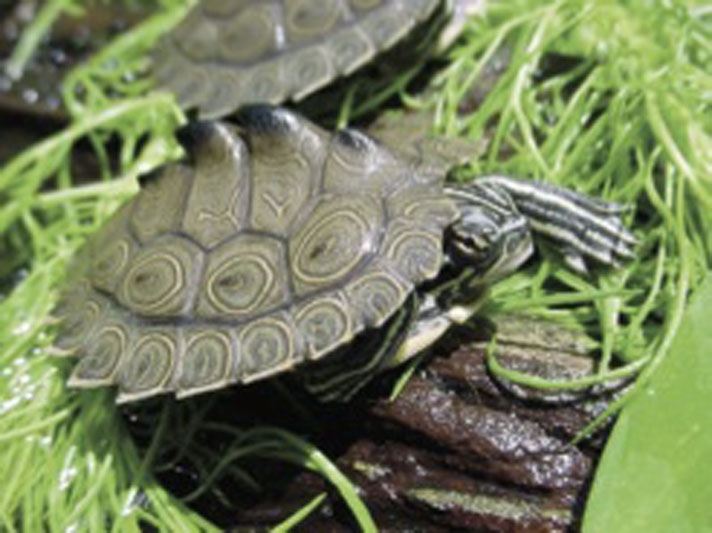
Paul Vander Schouw
Though similar to the nominate subspecies, the delta sawback (Graptemys nigrinoda delticola) has brighter light colors and darker dark pigmentation than its cousin, the black-knobbed sawback.
Sawback hatchlings are rather flat, although the prominent saw-toothed keel for which they are named is present from hatching. The marginals are flared and strongly serrated. Sawbacks also exhibit sexual dimorphism, though not to the extreme degree of the broad-headed maps. Females’ shells deepen and the keel becomes reduced as the turtles grow, to the extent that adults lose nearly all evidence of the keel in advanced age. Females grow to around 9 inches. Males generally maintain their juvenile appearance throughout their lives, although their elongated fore-claws (used for courtship) and longer, thicker tails denote sexual maturity. Typically smaller than the females, males normally grow to only about 5 inches.
Both sexes and all age groups show a preference for the water’s periphery, rarely straying far from tree-fall snags that do not contact the shoreline. Below the surface, sawbacks hunt and feed on aquatic insects, fish, and small crustaceans and mollusks in and around the snags. At night, the turtles perch in the snags while sleeping. Above the surface, snags are used for basking during the day.
The coloration of each species in the sawback group is different and, in some cases, breathtaking. The yellow-blotched sawback (G. flavimaculata), for example, is considered by some to be the most beautiful species of turtle in the United States. It occurs in the Pascagoula River system, which includes the Chickasawhay and Leaf rivers. Like the Pascagoula map turtle, with which it shares its range almost exactly, the yellow-blotched sawback is a Mississippi endemic. The soft parts are black with yellow stripes, the carapace exhibits thin gray or black rings on a bright yellow background, and the plastron is yellow tinged with orange. The dark scute seams extend onto the scutes in semi-geometric patterns.
The black-knobbed sawback turtle (G. nigrinoda) is found in the Alabama, Black Warrior, Cahaba, Coosa, Tallapoosa, Tensaw and Tombigbee rivers in Alabama and Georgia, which closely follows the range of G. pulchra. As the common name suggests, the vertebral keel is comprised of black, rounded, knob-like protuberances. The northern black-knob (G. n. nigrinoda) has narrow cream to yellow rings on an olive carapace. The skin is gray with cream and yellow stripes. The plastron is pink to orange, with no pattern aside from dark scute seams. The Delta sawback (G. n. delticola) has thicker yellow rings on the dark-olive carapace scutes. The skin is dark gray to black, with thin cream stripes. The plastron of the Delta sawback is heavily patterned with black.
The ringed sawback turtle (G. oculifera), with a range matching that of G. pearlensis, occurs in the Pearl and Bogue Chitto rivers in Louisiana and Mississippi. This species vaguely resembles the Delta sawback, except that the bright orange rings of G. oculifera are much bolder and brighter than those of G. n. delticola. The seam-following plastral pattern, too, is more similar to that of G. flavimaculata.
The Remaining Graptemys
The remaining species of map turtles are considered neither broad-headed nor sawbacked. Some literature refers to them as narrow-headed, though this is a bit of a misnomer because older females of some of these species certainly develop grossly enlarged heads.
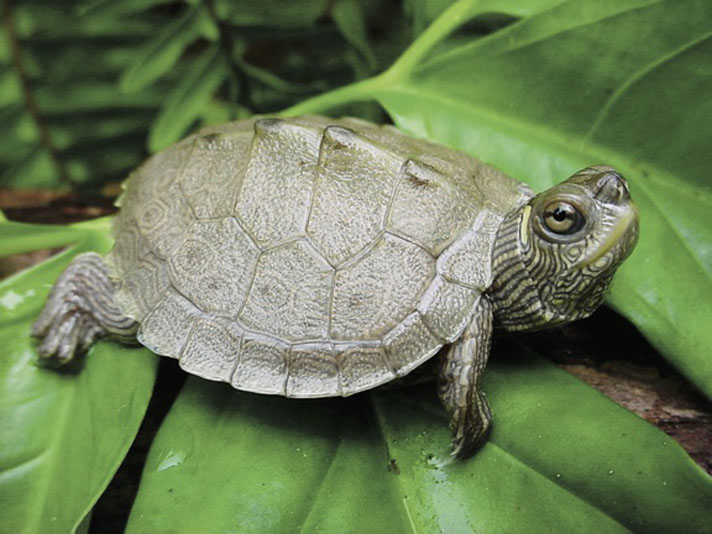
Paul Vander Schouw
False map turtle (Graptemys pseudogeographica pseudogeographica).
Hatchlings of these maps all possess keels to some extent, though they are not nearly as pronounced as the keels of the broad-heads, or as spiky as those of the sawbacks. The marginals are moderately to strongly flared and strongly serrated. Sexual dimorphism is also evident to varying degrees according to species. Females possess the typical deeper shell profile, reduced keel and larger size than males, but maximum size varies from species to species. Males typically remain similar in appearance to juveniles. Only some develop elongated fore-claws for courtship displays, though a longer, thicker tail is common to males of all map species.
While all species of Graptemys are essentially riverine in nature, some tend to traverse land more frequently than others, thereby expanding their range to include lakes and ponds. Coloration and dietary preference also varies from one species to the next.
The Northern map turtle (G. geographica) has a broad range, extending from southern Quebec, Canada, southward along the western side of the Appalachians to central Alabama, westward across Tennessee, down into central Arkansas, up into eastern Kansas, northward through the eastern half of Iowa into southeastern Minnesota, and back eastward through the Great Lakes states. There are also disjunct populations in New York, New Jersey and Pennsylvania. This species has been recorded in rivers, streams, lakes and even ponds.
The vertebral keel is weak, even in hatchlings. Carapace color is tan or brown, and some individuals have a fine network of orange or yellow irregular lines. The skin is brown, gray or black, usually with yellow stripes, although some specimens exhibit striking gold striping. The head pattern is not consistent or distinct enough to be useful for identification purposes. Though the pattern on the yellow plastron is not always limited to dark scute seams, most individuals are relatively patternless. Adult males may reach up to around 7 inches, and females about 10 inches. Very large females develop enlarged heads, but males do not develop elongated fore-claws for courtship.
The false map turtle (G. pseudogeographica) occurs in the Missouri, Mississippi and Ohio rivers, as well as associated streams and oxbow lakes. Escaped and released pets have resulted in records of this species well outside its historical range. Hatchlings have a moderate vertebral keel, but this subsides with age in both sexes. Carapace coloration is brown or gray, with a black dorsal stripe and usually a black blotch or smudge on each costal scute. The plastron is cream or yellow with dark scute seams and an extensive seam-following geometric pattern. Skin coloration is brown or black with cream or yellow stripes. Males can reach 8 inches and develop elongated fore-claws, while females can sometimes grow to more than 10 inches.
The false map exhibits a hockey-stick-shaped bar behind each eye, and the eye has a prominent dark bar passing horizontally through the iris. Older females do not develop enlarged heads. The Mississippi map turtle (G. p. kohnii) possesses a crescent-shaped stripe along the posterior rim of the eye, and pure specimens have an unmarked iris. Females of this subspecies occasionally develop enlarged heads.
The Ouachita map turtle (G. ouachitensis) ranges across the Ouachita River Basin, and can be found primarily in associated flowing waterways and tributaries. This species is somewhat similar to, and frequently confused with, G. pseudogeographica, and was once considered a subspecies of the false map.
The moderate vertebral keel of hatchlings diminishes with growth, though it is rarely lost altogether even in adult females. Females of this species can grow to just over 7 inches and do not develop enlarged heads; males rarely reach 6 inches and do develop elongated fore-claws for use in courtship displays. Coloration is highly variable in this species. The carapace is brown, gray or black, though the vertebral keel and centers of the costal scutes are usually darker than the base coloration. Like G. pseudogeographica, skin coloration is brown or black with cream or yellow stripes. The head pattern is highly variable, as well; some localities have a square or rectangular blotch behind the eye, while others have a complete facial mask reminiscent of the broad-head map species. There is some recent genetic evidence to suggest that these local variations may warrant taxonomic distinction.
The Sabine map turtle (G. sabinensis) is found in the Sabine River and associated flowing waterways along the Texas/Louisiana border. Overall coloration is similar to G. pseudogeographica and G. ouachitensis, both of which it has been considered a subspecies in the past. Possibly the most striking feature of the Sabine map turtle is its almost absurdly small head, even in females. Males rarely exceed 5 inches, and develop elongated fore-claws. Females rarely exceed 8 inches.
The Texas map turtle (G. versa) occurs only in the Colorado River and its tributary streams and peripheral lakes in central Texas. This is a small, brown species, with males barely reaching 5 inches and females growing to just over 8 inches. The carapace is minimally keeled and shows a network of irregular golden-yellow lines, and the plastron is patternless save for dark seams. Unlike any other Graptemys, the vertebral stripe of the Texas map is lighter than the base color of the carapace. There is a J-shaped marking behind each eye and three round spots on the chin. Males have elongated fore-claws, and although G. versa is typically considered a narrow-headed species, old females can develop enlarged heads.
The Cagle’s map turtle (G. caglei) is found in the Guadalupe, San Antonio and San Marcos rivers and associated flowing waterways in south-central Texas. Carapace and skin coloration is green with cream or yellow stripes. There is frequently a crescent-shaped stripe behind the eye, similar to G. p. kohnii. The plastron is yellow, cream, or almost white with broad dark scute seams, and there is a transverse bar under the chin. Males have elongated fore-claws and grow to just over 5 inches. Females develop rather large heads, despite this species being considered a narrow-headed species, and can reach almost 9 inches.
The Best Map Turtle Housing and Enclosure
Although map turtles can normally cohabitate quite placidly with other maps and other turtle species alike, there is always the potential for conflict. All species of Graptemys are active, vigorous turtles. They can intimidate more passive or less energetic species if they are housed together. Introductions should be carefully supervised to ensure that problems do not occur.
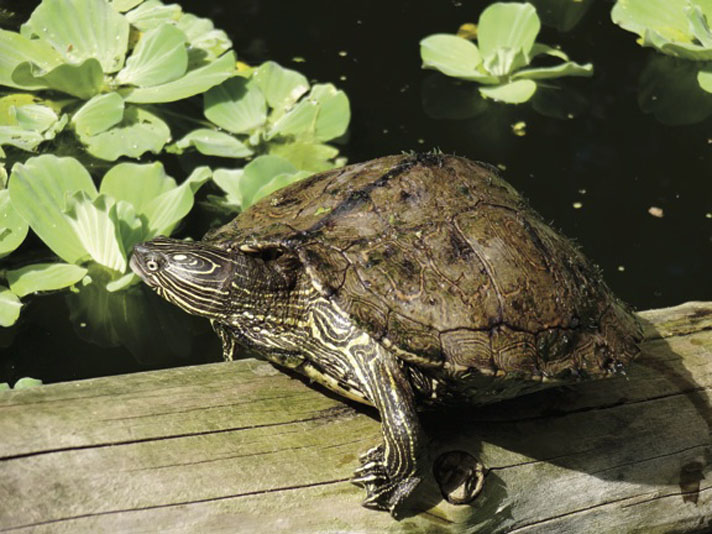
Paul Vander Schouw
Caught in a typical pose basking on a log, map turtles like this adult female Graptemys sabinensis are wary and ready to drop back into the water at the slightest hint of a threat.
Despite being resilient and adaptable, wild map turtles can frequently be difficult to adapt to captivity. A captive-bred map turtle is always preferred over one taken from the wild. Captive-bred turtles are adapted to captive conditions from the moment they hatch. Their likelihood for harboring parasites or being vectors for disease is virtually nil, and they tend to be more docile than their wild-caught counterparts.
Pet map turtles can be housed in a variety of different ways, but some specific conditions are required if they are to remain healthy and active, and husbandry requirements are basically the same at all stages of life.
Hatchling and juvenile map turtles can be set up with something as simple as a mortar tub, and glass aquariums, plastic totes, and steel or plastic stock tanks are suitable for turtles of any age, size or sex. The maximum tank size is unlimited because maps are excellent swimmers, but at a minimum there should be 5 to 10 gallons of water per inch of carapace length. This means that the average adult Graptemys may need a tank up to 100 gallons or more. Keep this in mind before you purchase a hatchling!
Any tank furnishings should be securely fixed in place to prevent the turtles from accidentally (or intentionally!) shifting or upending them. Although they are active and energetic, even large adult female map turtles can become stuck beneath a heavy object and drown.
Substrate is not necessary, but if used should be easily cleaned. Sand, crushed coral and river pebbles are all acceptable materials, but rough, abrasive stone objects should be avoided. Scrapes and scratches on the skin, or even shell scutes, can make a turtle susceptible to infection.
Clean water is very important, and frequent water changes or a strong, oversized filter will be needed to prevent the buildup of waste and toxins in the water. This also retards the proliferation of bacteria and fungi, further enhancing a healthy captive environment. Live or plastic plants, or a combination of both, can enhance the aesthetics and environmental quality of the tank. They will provide behavioral enrichment as the turtle clambers around and explores, and live plants will consume waste which will help maintain water quality.
All species of Graptemys bask avidly, so suitable basking accommodations are essential if pet map turtles are to remain healthy and vigorous. Basking raises a turtle’s metabolism to facilitate digestion and bolster the immune system. It also allows the skin to dry completely, permitting dead skin and old scutes to shed properly. Skin infections, shell rot and ear abscesses are just a few potential health problems that can result from failure to provide sufficient basking accommodations. Secure and stable structures made of natural and artificial materials, including driftwood and commercially manufactured plastic basking docks, can be arranged to be functional and also contribute to the visual appeal of the turtle tank. Providing a safe structure, such as a tunnel or cave, below the water’s surface will also afford a secure hiding spot, but be sure your turtle can maneuver easily through it in order to prevent drowning.
Map Turtle Heating and Lighting Recommendations
Heat lamps are effective for regulating air and basking temperatures within Graptemys enclosures, and aquarium heaters will do the same for their water. Heat lamps should be placed no closer than 12 inches from the height of the largest turtle to prevent burns and general overheating. In the water, titanium heaters are strongly recommended for any turtle species; a protective guard will be required if a glass heater is used to prevent breakage.
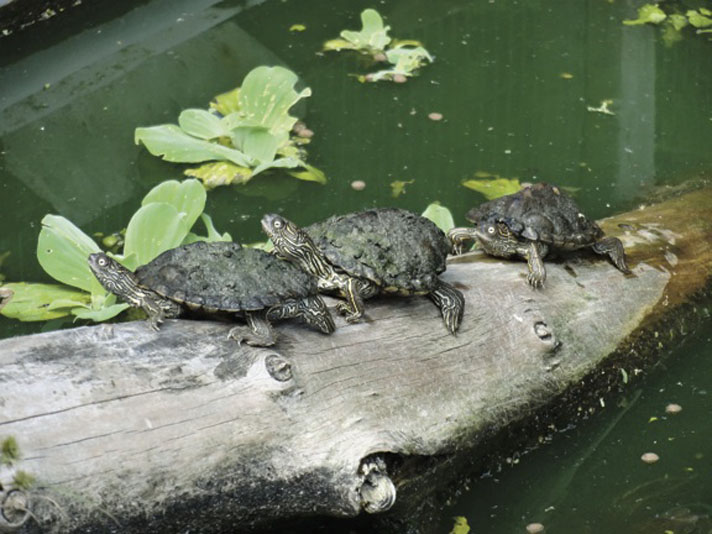
Paul Vander Schouw
Gregarious baskers across the genus, map turtles such as these Texas maps (Graptemys versa) will crowd a favored basking log, seeking to soak up the warming rays of the sun.
Water temperatures should be between 70 and 80 degrees Fahrenheit. Air temps should be kept a few degrees warmer, around 75 to 85 degrees, and the basking spot should reach upwards of 90 to 100 degrees at its hottest point. These temperatures can be allowed to drop about 5 degrees at night and another 5 degrees during the winter. Under natural conditions, wild map turtles can tolerate temperatures well beyond the range for their optimum activity, but subjecting pet turtles to these extremes is neither necessary nor recommended.
Although there is no absolute substitute for natural, unfiltered sunlight, creating a basking spot with such exposure accessible to pet turtles is not always feasible (and if it is, great care should be taken to prevent accidental overheating of the turtle in its housing). There is a plethora of light bulbs available for purchase that will produce the range of UV suitable to facilitate the synthesis of vitamin D3, the crucial nutrient required to metabolize calcium for healthy bone and shell growth. The selected bulb must provide wavelengths in the UVB range (the bulb’s packaging should indicate this), as UVA alone is inadequate and in actual fact useless for vitamin D3 synthesis.
Although some species of Graptemys have a very specialized diet in nature (especially the broad-headed species), in captivity they will readily accept commercially manufactured food pellets. There are numerous brands on the market, and providing map turtles with a nutritious diet can be accomplished by selecting one with a 30- to 40-percent protein content, low-fat content (less than 20 percent), and a high calcium-to-phosphate ratio. Earthworms, crickets, crayfish, feeder fish, bloodworms, blackworms and various leafy greens including romaine, red leaf, greenleaf, endive, escarole and kale can also occasionally be provided as treats.
Map turtles are as remarkable in their diversity as they are in their behavior. Despite being demanding in certain respects, raising healthy, lively turtles by providing for their specific needs is highly rewarding. When their essential needs and requirements are fulfilled, these beautiful creatures make brilliant pets for the dedicated keeper.
PAUL VANDER SCHOUW is an avid turtle hobbyist from west-central Florida. A mechanical engineer by profession, he maintains about 1,000 individual turtles representing more than 100 species and subspecies. He has successfully bred more than half. Chelid side-necked turtles are his primary interest.


